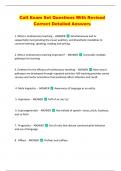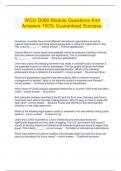Samenvatting
Samenvatting Marketing - VOLLEDIG + effie cases + gastcolleges (15/20)
Met dit document hebt u een VOLLEDIGE samenvatting van het vak marketing gegeven door Nathalie Dens in de eerste bachelor. Het bevat een samenvatting van de powerpoints, het boek, de effie cases en alle gastcolleges. Dankzij deze samenvatting was ik er zelf ruim door op mijn examen.
[Meer zien]












